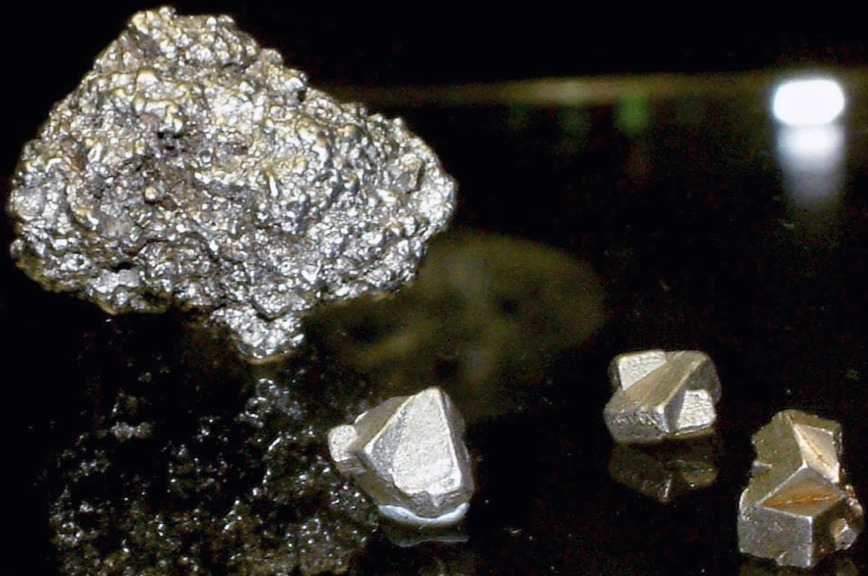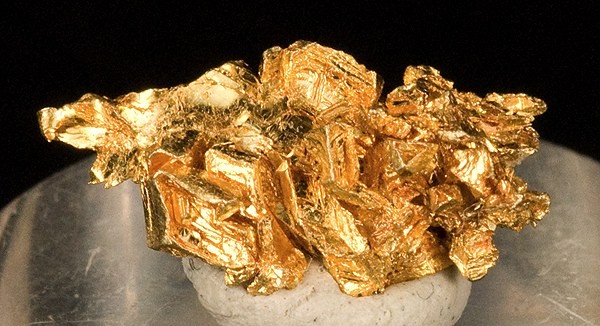Usually, precious metals are only known to the public in highly refined and polished form, such as jewelry, coins, or great works of art. However, some of the most valuable and beautiful silver and gold items owe none of their beauty to human artistry. The natural crystallization that occurs in gold and silver are typically found as nuggets or in rockbound veins. If the circumstances of their formation allow it, they will take on gem-like shapes with perfect geometric symmetry, almost appearing to be ‘nature’s sculptures.’
Precious metals
Platinum, silver, and gold are precious metals. The main characteristic that distinguishes gold and silver from the roughly 100 elements that make up all of earth’s matter is their exceptional durability. Gold and platinum are among the few metals that are commonly found in their native pure state uncombined with other elements. Nearly all the gold ever mined is still in existence today, in one form or another. Silver is second only to gold in its nobility.
Early civilizations associated gold with the sun and considered it masculine. They regarded silver as feminine and linked it with the moon. Gold has been long prized as a symbol of life and immortality. For many people, the whiteness of silver represents purity.
Noble metals
The noble metals are the royalty of metals. Because they don’t interact with the crowd, they aren’t like the other elements on the periodic table, who are always “interacting” with others. The term “noble metal” dates back to at least the late 14th century, describing metallic elements that are relatively unreactive to oxygen. The most distinctive quality of noble metals is the chemical inertness that makes them almost impervious to corrosion.
Aside from silver and gold, the six platinum group metals (ruthenium, rhodium, palladium, osmium, iridium, and platinum) are also called noble metals due to their rarity and the fact that they are often found close to each other in nature.
Gold
Success
You are now signed up for our newsletter
Success
Check your email to complete sign up
The chemical symbol for Gold is Au. Resistant to air, water, salt, and most acids, it is unrivaled in terms of versatility, durability, and the eternal allure of its lustrous yellow shine. It has been stated that the history of gold is the history of the whole world.
Gold, which is both portable and easily accepted, has evolved into the currency of commerce between peoples and countries, as well as the motivator of conquering armies and expeditionary journeys. It is the stuff on which empires have been built and for the lack of which they have fallen. No civilization has risen to greatness without it.
Gold is used in finances and investing, dentistry and medicine, aerospace, medals, awards, electronics and computers.
Fun Fact: Did you realize that your iPhone has a virtual gold mine? Well, not exactly – Mobile phones contain about 0.034g of gold, which is worth approximately US$1.82 at current rates.
Atomic secrets of precious metals
Many of the qualities that set the noble metals apart from other elements can be traced to the independent performance of a single electron. The atoms that constitute every element contain a specific number of electrons whirling in concrete orbits called shells around a nucleus. An atom of gold has 79 such electrons in orbit, platinum has 78 and silver has 47. Inner-orbit electrons are stable and ‘closed;’ those in the outermost valence or shells are less attracted to their nucleus, may move freely, and interact with other atoms.
A gold, platinum, or silver atom has a single electron that is the freest which moves at a high speed. The millions of atoms that make up a piece of metal share these free electrons, which are not bound to any one atom. With their ability to transmit electricity, heat, and even light, these wandering particles create an electron cloud that gives valuable metals their malleability and even their luster.
Fineness is a measure of gold or silver purity. Gold fineness is typically represented as a karat grading; silver fineness is a percentage. Karats are based on 24. 24-carat gold is 99.9% gold. Malleable and ductile metals are soft and easy to work with. Gold can be flattened into sheets less than four millionths of an inch thick and used as gold leaf for gilding. An ounce of gold can be drawn into a wire more than 40 miles long.

Alchemy (which lasted far into the 19th century) sought to convert base metals into gold. It may seem inconceivable, but even intellectual giants like Sir Isaac Newton and Tyco Brahe believed in alchemy.
Silver
Silver is represented by the symbol Ag on the periodic table, representing the Latin word Argentum, which correlates to the metal’s shiny or white appearance. Silver-bearing rocks have a dark, almost sooty surface, or dark crystals inside. Geographically, there are many kinds of silver ore. Some have spider-like veins in the rocks, while others are more gray or black. Silver is present in quartz and ruby crystals. Silver and gold are frequently found together in the same ore.
Crowns with silver embellishments and ornamentation date back to 4000 BCE. By 800 BCE, gold and silver were probably utilized as money in all nations between the Indus and the Nile.
Platinum, gold, and silver are used to make jewelry because the metals used in jewelry are always chosen on the basis of their reactivity. They are highly lustrous metals that are resistant to corrosion. Silver features a refined look and ensures great strength. Moreover, because silver is more affordable, silver jewelry can be purchased by the multitudes.
Silver has always been considered magical because it never rusts, does not react with other substances, and even helps to maintain the freshness and purity of food and water. Ancient peoples who had no understanding of science or biology were aware of silver’s antibacterial qualities for food and medicine.
Throughout history, silver tinctures and powders were often administered to wounds to prevent the spread of infection and sepsis.
Silver is used in electronics, cables, and connections. Silver is also present in laptops, mobile phones, TVs, DVD players, long-life batteries, and other electrical gadgets. It’s utilized in high-temperature ball bearings, such as in engines. Silver is used in flexible computer screens, and LED lighting. The use of silver in solar panels is perhaps the most well-known use since the sector has grown in popularity recently.

Platinum group metals
Platinum, a chemical element with the symbol Pt, is the most plentiful group element.
The name is derived from the Spanish ‘platina,’ meaning little silver. Platinum’s worth stems from its extreme rarity – 30 times the rarity of gold. Platinum also has a high density. It is the third densest natural element, known to exist, after osmium and iridium.
In the late 18th century, platinum powder was melted onto porcelain. The 20th century’s technical advancements made the metal more practical but also generated a demand that drove its price far above silver. Dinnerware was no longer an option, and platinum joined gold and silver as preferred metal for some of the world’s best jewelry.
In 1908, the 516-carat Star of Africa was set in platinum on the British Royal Scepter, while the Koh-i-Noor of India was cut from 800 to 106 carats for the State crown of England also rests in platinum. Because of its tensile strength, a single ounce of platinum can be spun into a wire that is more than two miles long.
Palladium, Pd, is named after the Greek goddess of wisdom, Athena or Pallas. Palladium has been found uncombined in nature in Brazil. Palladium is silver-gray in color. Most palladium is used in catalytic converters for cars. It is used in the electronics industry in ceramic capacitors, found in laptop computers and mobile phones.
Rhodium, Rh, is derived from the Greek word ‘rhodon,’ meaning rose. This symbol of a rose is usually found with the motto ‘Dat Rosa Mel Apibus,’(The rose gives the bees honey), a metaphor for eternity. Rhodium is a rare white platinum group metal used in jewelry electroplating. Like Palladium, rhodium is also commonly used in automobile catalytic converters, as it helps to decrease nitrogen oxides in exhaust gases. Coating optic fibers and optical mirrors, as well as crucibles, thermocouple components, and headlight reflectors, are some other applications.
Ruthenium, Ru, is one of the rarest metals on the planet. It can be found in nature in its uncombined form; the name is taken from ‘Ruthenia,’ which is the Latin word for Russia Ruthenium has several uses. It is used to strengthen platinum and palladium alloys, and also in electronic chip resistors and connectors.
Iridium, Ir, is named after the Greek goddess of rainbows, Iris. The dragonfly’s iridescent wings symbolize both the element’s name and its colorful salts. It is almost as inert as gold and its density and melting point are high. It is the second densest natural element in the world. Iridium is found uncombined in nature in sediments that were deposited by rivers. Iridium is the world’s most corrosion-resistant metal. It is used as pen tips and compass bearings, and in an alloy with osmium. Its high melting point and low reactivity make it ideal for spark plug connections.
Interestingly, The Earth’s crust has a thin coating of iridium, believed to be from a huge meteor or asteroid that struck the Earth, possibly the same meteor or asteroid that the extinction of dinosaurs is attributed to. Iridium is commonly found in meteors and asteroids, but not in the Earth’s crust. It is theorized that the collision created a massive dust cloud containing iridium, which then settled on the Earth’s surface.
Righteous bonding
Someone once posed this question to a wiseman: Noticing that the chemistry between individuals uniting for a selfish purpose was generally much stronger than virtuous people joining hands for a noble cause, he asked, “Why?”
The Yogi explained that in chemistry, there is a class of elements called noble metals, so named because they react and associate less. These metals which include silver, gold, and platinum, are not only lustrous, but precious too.
In the wild, Hyenas are more likely than Lions to establish a crackle, yet lions thrive. Smaller numbers do not diminish the power of a pride. Perhaps this is the way of life; negative individuals are stingy and sticky within, which is why they cling together outwardly, only to break apart later since their ties only serve their ulterior motive. A small number of noble people can create a powerful alliance to battle the evil forces and fight not only for their own rights, but also to fight for what is right.















